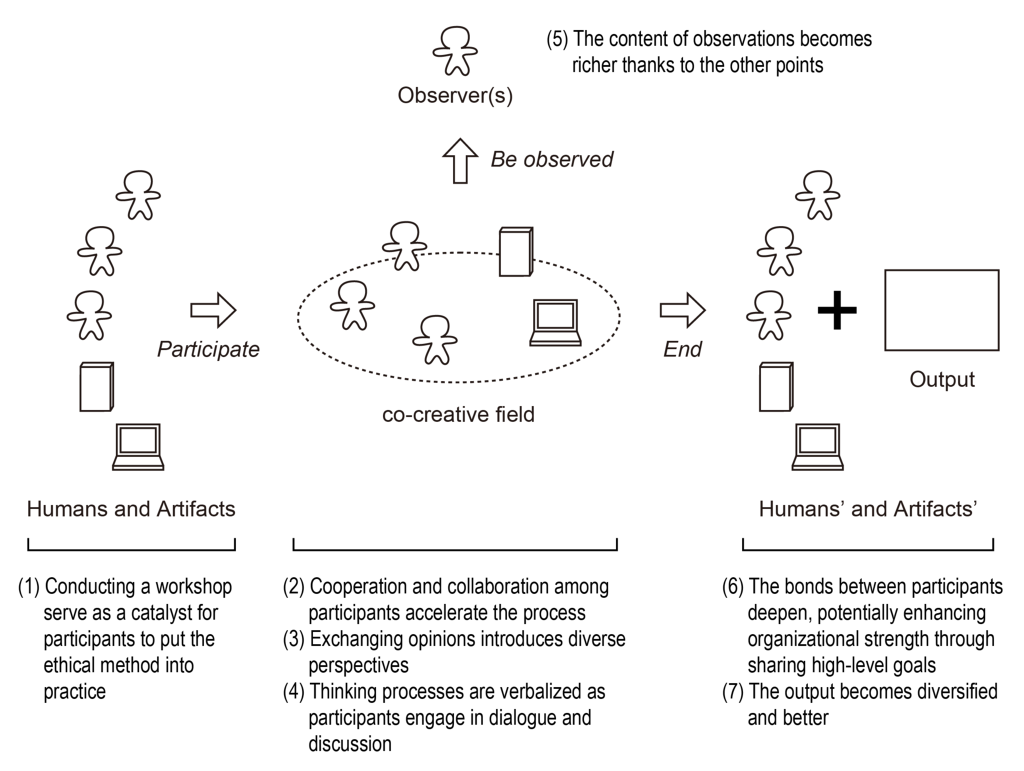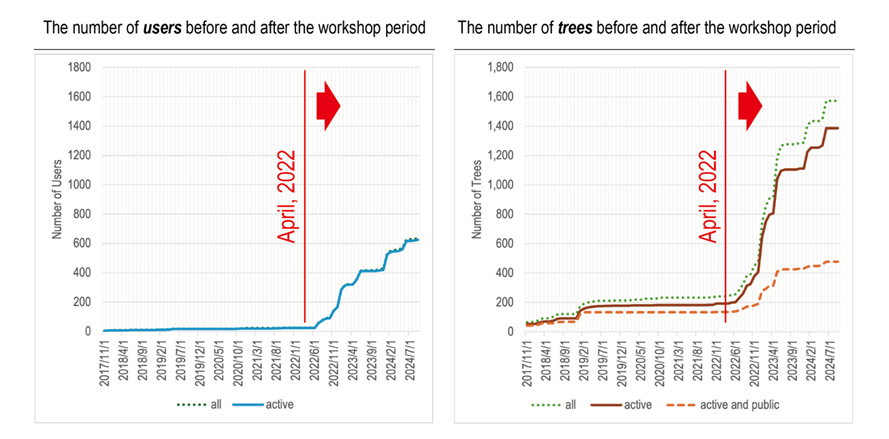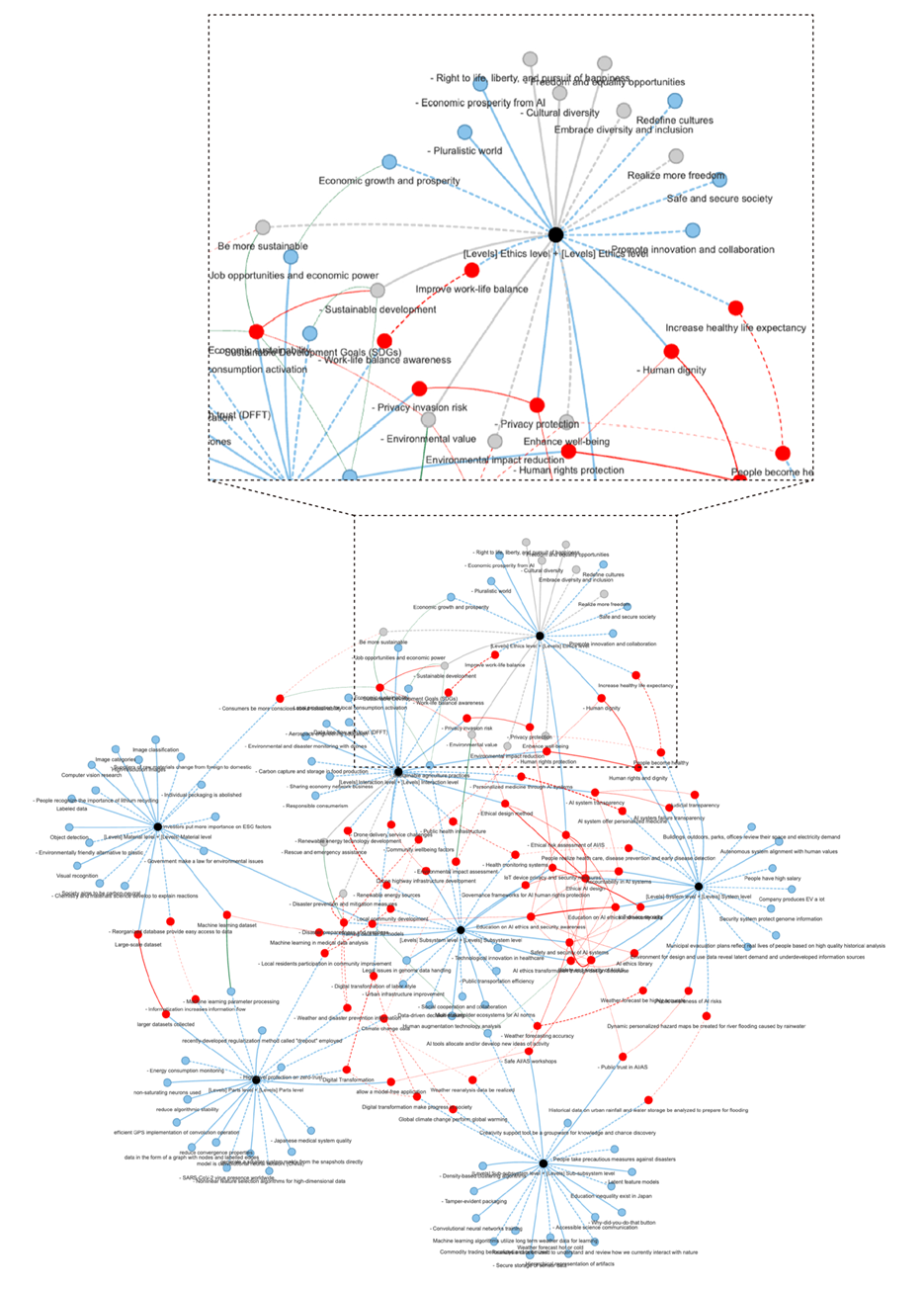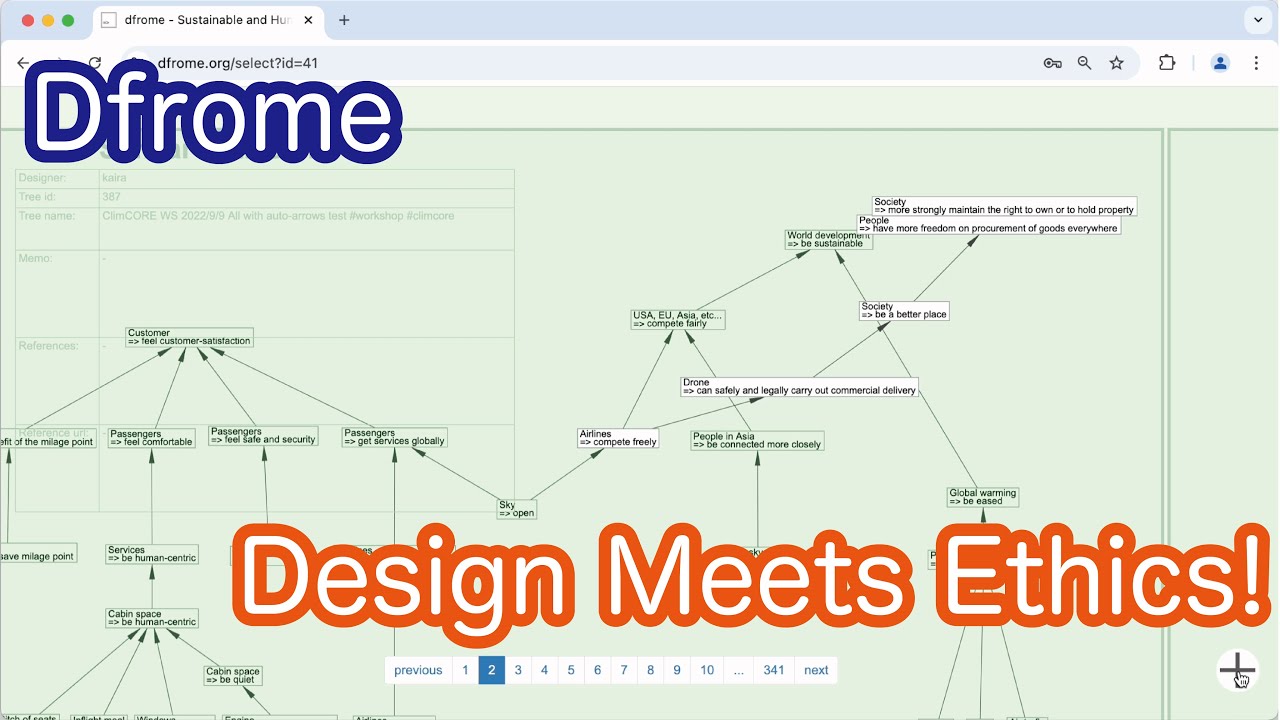Guest authors: Kaira Sekiguchi, Yukio Ohsawa
Bridging Ethics and Engineering: A Three-elements Approach
Have you ever wondered how we can make technology development more ethical? As researchers on artificial intelligence (AI) and design, we've been tackling this challenge through a three-elemental approach by creating workshops that help engineers think about ethics using a design support tool based on ethical design method.
The three elements of our approach are as follows:
- Ethical Design Method: A structured method that systematically connects artifact internal environments, such as mechanical structures, to broader societal contexts. This method enables engineers to seamlessly consider ethical (socially valuable) implications from high-level values to concrete implementation details.
- Design Support Tool (Dfrome): An organic and dynamic web-based platform that operationalizes the ethical design method.
- Co-Creative Workshops: Collaborative sessions that bring the method and tool into practice, creating an environment where ethical design becomes an active, shared endeavor.
What is Dfrome?
We've developed "Dfrome," an innovative design support tool that bridges the gap between technical development and ethical considerations [1-3]. This web-based platform serves a crucial purpose: helping engineers systematically incorporate ethical thinking into their design process.
Dfrome achieves this through several key features:
- Integration of ethics as a natural extension of system design
- Interactive editing capabilities
- AI-powered support that suggests relevant scenarios from past projects
We invite you to learn more about Dfrome through our introduction video:
Movie 1. [Dfrome] Design Meets Ethics! - Dfrome in 3 Minutes
Here, Dfrome’s data is organized in a tree-like structure that shows the relationships between ethical considerations and design decisions. These structures are referred to as 'trees.'
Theme, Goals, and Expected Outcomes of Workshops
Our recent workshops have centered on the concept of “Nigiwai” (a community’s prosperous vibrancy) -- exploring how to create lively atmospheres in various contexts such as urban spaces, customer environments, and workplaces.
Through the workshops, participants develop capabilities in:
- Designing artifacts that create social value
- Identifying and utilizing relevant datasets relevant to the design ideas
Organizing a co-creative workshop is effective in seven ways, as illustrated in Figure 1.

Figure 1. Seven effects of co-creative workshops
The outcome of process 7 is the tree-form design structure that connects participants’ research or business projects with the ethics level. Based on this structure, others---including philosophers and citizens---can provide valuable alternative perspectives and feedback on these design ideas. Ideally, if participants are inspired by the workshop, they will use this method more and there will be an increase in the number of users and trees.
Growth in the Workshop Period
After bringing together all three elements in our laboratory in April 2022, we've seen significant growth compared to the previous period. Based on data from October 1, 2024, Figure 2 shows this growth in terms of user numbers and design projects:
- The total number of users reached over 600 (27x increase)
- Active (not deleted) trees reached approximately 1,400 (7x increase)
- Publicly available (active and public) trees grew to about 480 (3.5x increase)

Figure 2. Quantitative difference before and after the workshop period: Number of users (left) and trees (right)
Diversification of User Community
While Dfrome was originally conceived as a tool for engineering professionals, our workshop program revealed its potential as a platform for diverse stakeholder engagement. The tool has evolved into a common platform where different perspectives can meaningfully interact and influence design decisions.
For the same period as the data above, the composition of our user community reflects this and approximately:
- 59% comprise students and professionals from systems innovation, information technology, and medical fields and some working adult students.
- 16% joined through collaborative research and outreach initiatives.
- 2% represent participants from philosophy seminars.
Qualitative Changes in Design Thinking
The nodes in Figure 3 demonstrate how Dfrome's knowledge base has diversified over time. The platform has attracted various users, including engineering students and business professionals, leading to an accumulation of design ideas from different perspectives. This diversification is evident in the qualitative changes observed in the Dfrome tree keywords before and after the workshop period.
The definition of this graph in Figure 3 is:
- Each black node in the graph corresponds to different levels in the hierarchical representation of artifacts.
- Keywords connected by solid lines represent those from the pre-workshop period.
- Keywords connected by dashed lines represent those from the post-workshop period.
- Gray keywords indicate overlap between both periods (and red segments indicate similar relationships between keywords).
The figure demonstrates that new keywords emerged across all levels, including the ethics level, as evidenced by the additional keywords connected with dashed lines at each level.

Figure 3. A visualized network diagram that illustrates how Dfrome projects have grown more diverse over time.
Join Us in Shaping Ethical Technology
As researchers on AI and design, we are writing this blog to invite participants to our workshop and to connect with potential partners for future collaborative research projects. AI development was originally deeply connected with philosophy, and it should continue alongside philosophical thinking, not just user ethics. Our approach embodies this vision by collaborating with philosophers of science and technology.
We are especially seeking international collaborators to expand our practice, particularly with the ESDiT and 4TU communities. If you're interested in getting involved:
- Watch our afore-mentioned YouTube movie
- Explore Dfrome: www.dfrome.com (now www.dfrome.org)
- Contact us about workshop organization
Please reach out to Kaira [at] sys.t.u-tokyo.ac.jp for collaboration opportunities.
References
[1] Sekiguchi K, Hori K (2020) Organic and dynamic tool for use with knowledge base of AI ethics for promoting engineers’ practice of ethical AI design. AI & Society 35:51--71, DOI https://doi.org/10.1007/s00146-018-0867-z
[2] Sekiguchi K, Hori K (2021) Designing ethical artifacts has resulted in creative design: Empirical studies on the effect of an ethical design support tool. AI & Society 36:101--148, DOI https://doi.org/10.1007/s00146-020-01043-6
[3] Sekiguchi K (2022) Research on design extending to the ethical aspects of artifacts. PhD thesis, Graduate School of Engineering, the University of Tokyo, (in Japanese).
[4] BaleeGraph of the difference in keywords before and after the workshop period (Fixed on October 28, 2024).
https://baleegraph.com/gallery_merge?p_id=1402&s_id=1403&b_th=90&k_th=90&c_th=90
Acknowledgements
The University of Tokyo's DFIL social collaboration course, JST Grant Number JPMJPF2013 and Project Number 236100000155 (ClimCORE), JP-MXS0118067246 (Q-Leap), and the MEXT Initiative for Life Design Innovation provided support for this study.
About the author
Kaira Sekiguchi is a Project Researcher and Yukio Ohsawa is a Professor at the School of Engineering, The University of Tokyo. Their research interests include artificial intelligence, data utilization and system design for social benefit.




